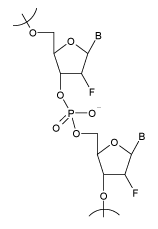
2´F-modified RNA from TriLink Used to Modulate the Immune System through Activation of RIG-I
March 2016
Modified RNA has been of interest for some time due to its relevance in the therapeutic landscape. In particular, immune activation by therapeutic RNAs can be advantageous for treating cancers. Earlier this year, researchers from Duke University published a study that utilized 2´Fluoro (2´F) modified RNA from TriLink to differentially regulate the activation of pattern recognition receptors (PRRs) of the immune system. The ability to modulate the immune system may provide a broader range of control and specificity that will enable greater therapeutic application targeting.

Though researchers initially focused on different categories of small RNA, such as RNA interference (RNAi) and small interfering RNA (siRNA) to control gene expression and regulate disease, more recently RNA aptamers and mRNA have gained traction and expanded the therapeutic capabilities of RNA.
The authors evaluated the affect of 2´F RNA on toll-like receptors (TLRs) 3 and 7 and retinoic acid-inducible gene-I (RIG-I), which are pattern recognition receptors (PRRs). PRRs are part of the innate immune system that have been shown to be activated by exogenous RNA and can lead to cell toxicity and death.

The authors found that 2´F modified RNA had a differential effect based on the target receptor. Specifically, they found that 2´F modification decreased stimulation of TLRs 3 and 7, while it significantly increased stimulation of RIG-I. To mimic RNA generated in vitro they tested 2´F 5´ppp RNA. They found that the addition of the 5´ppp led to caspase-induced cell death through RIG-I. This effect could be reduced by the deletion of 5´ppp and completely abrogated by addition of 2´OMethyl.
The effect of 2´F on immune modulation is still not completely understood. Characterizing the immune modulation capabilities of RNA is important because the desired immune response varies based on the therapy. For example, gene regulating siRNAs should evade the immune system, however it is advantageous for immunotherapy-based RNA applications to induce an immune response.

These results show that 2´F RNA, in conjunction with other modifications, can modulate the immune response. This may be useful in the development of RNA-base therapies. Specifically, the authors note that the 2´F 5´ppp modified RNA may be beneficial to target human melanoma cells which have been shown to be significantly more sensitive to RIG-I mediated cell death than normal cells, however the therapeutic potential goes far beyond this particular application.
Whatever your application or research area might be, TriLink has the expertise to synthesize your oligonucleotide. We offer over 39 million possible modification combinations so you can design custom oligonucleotides specific to meet the needs of your projects and experiments. Quickly and easily create and order your oligos using the TriLink online OligoBuilder.
And don't forget, since it's time for the NCAA March Madness Basketball Tournament ? its also time for the TriLink Annual ?Modified Oligo Madness? Tournament. Enter for a chance to win product credits and great prizes including an Apple Watch, an Amazon Echo, a Polaroid Cube, and more. Pick your teams and favorite modifications, then cheer them on to victory.
Featured products: 2´F RNA, 2´OMethyl and 5´ppp. Please contact us for a quote.
For additional information on 2´F modified RNA, see our product page. For additional information on modified oligos and oligonucleotide synthesis, please see our technical articles.

